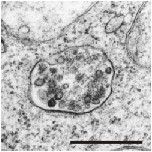The multivesicular body as the sorting device in the late endocitic pathway

Late endosomal sorting is the final determining step of the fate of endomembrane molecules such as signaling receptors. Molecules are sorted either to lysosomes for degradation, or to the recycling pathways (to the Golgi or to the plasma membrane) for reuse. We have established CHO mutants defective in the late endocytic pathway (LEX mutants). The late endocytic pathway can be divided into multiple trafficking stages that can be defined by the gene mutations of these mutants. These stages include the multivesicular body (MVB) that functions as a molecular sorting/distributing device and later endosomes that directly interact with lysosomes. The MVB is a unique vesicular structure that has a number of internal vesicles. Recently, the MVB has received much attention as the device that sorts materials between degradation and recycling pathways.
One of the mutants, LEX2, is defective in the sorting of cation-independent mannose 6-phosphate receptor (CI-MPR) from the MVB to the Golgi, and CI-MPR is arrested at the internal vesicles of large MVBs in LEX2 cells. This arrest was due to the lack of the normal NAD(P)H steroid dehydrogenase-like protein, an enzyme involved in the later stage of cholesterol biosynthesis, in LEX2 cells. The restoration of the normal free cholesterol levels in LEX2 cells allowed the exit of CI-MPR from the arrested MVBs to the Golgi, and lowers the number of the arrested MVBs. These results suggest that cholesterol is required for the transport of CI-MPR from the internal vesicles of MVBs to the Golgi. Cholesterol might have a role in maintaining an appropriate equilibrium between internal vesicles and the limiting membrane within an MVB.
